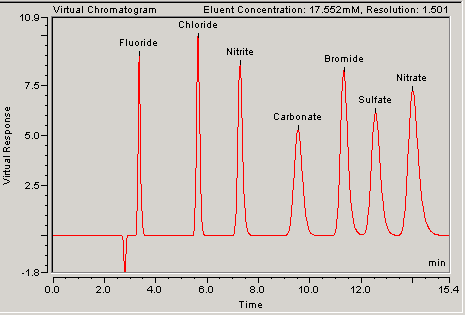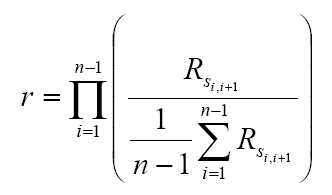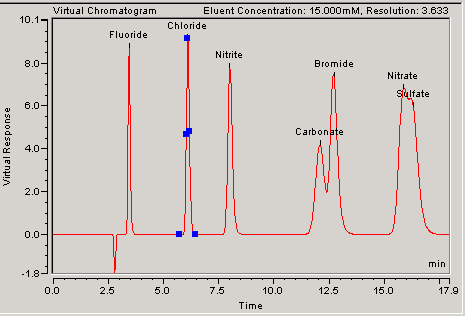Simulating Chromatograms
![]() Selecting a Resolution Criterion
Selecting a Resolution Criterion
Virtual Column provides three options for determining the optimal eluent condition for peak resolution:
Minimum Resolution
Normalized Resolution Product
Resolution Optimized for Analyte
To select a resolution criterion, right-click on the Resolution Response Surface and select a criterion on the menu, or select an option on the Criterion menu on the Chromeleon menu bar.
The sections below describe each resolution criterion. Examples illustrate how each criterion affects the same Virtual Chromatogram. For the examples, the AS18 column was selected and the following list of anions was used: Bromide, Carbonate, Chloride, Fluoride, Nitrate, Nitrite, and Sulfate. Note: Carbonate was added to the list to better illustrate the differences among the criteria.
Minimum Resolution
When Minimum Resolution is selected, Virtual Column finds the least resolved peak pair for the selected eluent condition. The resolution of the entire chromatogram for that eluent condition is defined as the resolution of the least resolved peak pair. All other peak pairs of higher resolution are ignored. Minimum Resolution is the default criterion. This option is useful for difficult separations because it optimizes the resolution of any peak pairs that are hard to separate.
In general, a resolution value of at least 1.5 (peak areas overlap less than 0.2%) is regarded as good baseline separation. For many applications, a value of 1.2 (peak areas overlap less than 2%) is considered to be an acceptable separation. A value of 0 indicates that at least two peaks are eluting at the same retention time.

Normalized Resolution Product
When Normalized Resolution Product is selected, Virtual Column finds the eluent condition that provides the most evenly spaced peaks across the entire chromatogram. A normalized resolution product value of 1 indicates that all peaks are evenly resolved across the chromatogram. A value of 0 indicates that at least one peak pair is co-eluting. Normalized Resolution Product is useful for easy separations, as it optimizes the resolution of all peak pairs. However, for more difficult separations, Normalized Resolution Product may find a chromatogram with evenly spaced peaks, but the peaks may not all be resolved.
The normalized resolution product (r) is defined by the following equation:

where n is the number of peaks and  is the resolution of peaks i and i+1.
is the resolution of peaks i and i+1.
Notice that with this example, when the Normalized Resolution Product option is selected, the Carbonate/Nitrite peak pair is no longer resolved.

Resolution Optimized for Analyte
When Resolution Optimized for Analyte is selected, Virtual Column finds the eluent condition that optimizes the resolution of a selected peak. Virtual Column finds the best resolution for the selected analyte. The resolution of the other peaks is not taken into account. Resolution Optimized for Analyte is useful if resolving a particular analyte's peak is more critical than resolving all other peak pairs.
In this example, Chloride is the selected analyte (indicated by the asterisk next to the Resolution value in the Display Results table and the blue markers on the peak). Notice that, with this option, the Carbonate/Bromide and Nitrate/Sulfate peaks are not resolved.


![]() Tip:
Tip:
When Resolution Optimized for Analyte is selected, you can select a different analyte to be optimized by double-clicking the analyte peak on the Virtual Chromatogram.